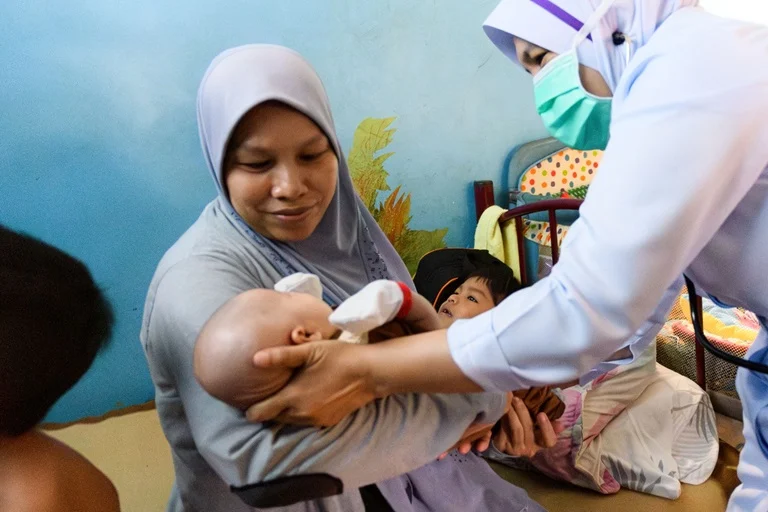Indonesia has one of the largest populations in the world, with more than 278 million people. However, healthcare in Indonesia still encounters problems to this day. Up to 62.9% of the population lack access to hospitals, and 60.8% lack access to primary healthcare facilities.
Healthcare Centers
Indonesia has a mix of private and public hospitals. As of 2022,
Indonesia has 1,058 public hospitals and 1,927 private hospitals.
Besides hospitals, Indonesia also has 10,205 public Health Community
Centers, or PUSKESMAS, which stands for 'Pusat kesehatan
masyarakat,' to provide primary health care and vaccinations.
Two types of PUSKESMAS are available: facilitation of inpatient beds
and provision for outpatients only. However, PUSKESMAS centers are
usually managed by a General Practitioner accompanied by a nurse or
midwife, as they only supply non-emergency medical care. Patients
will immediately be transferred to the nearest hospital if severe
illness or injuries present themselves. PUSKESMAS centers are also
located in many areas, making them available in many locations.
Additionally, quality differences exist between public and private
hospitals in Indonesia. Most public hospitals, especially those
outside Jakarta and other major cities, need more investment,
modernization, staffing, and professional capabilities. Private
hospitals are usually the opposite, with cleaner and more organized
hospitals, further modernization and technologies, and a higher
provision of professional capabilities. Moreover, patients in
private hospitals tend to spend less time waiting than those in
public hospitals.
Disparities in Urban and Rural Areas
Indonesia experiences unequal development between urban and rural
areas, with much more significant development experienced in urban
areas. Due to this, people primarily aim for jobs in urban areas.
Moreover, most people living in rural areas also have tremendously
low levels of education, even in primary school. Therefore, the
socioeconomic conditions in rural areas are much worse than in urban
areas.
In rural areas with a significant population being poor,
considerations regarding transportation and the time required for
hospital visits are taken into account. The expensive transportation
can be a problem, and the time needed to obtain healthcare means
time for work is well-spent. Due to these recurring problems,
citizens in rural areas may consider delaying their hospital visits,
leading to an increasing number of chronic diseases.
Furthermore, as salaries and research opportunities are better in
urban areas, specialist doctors tend to stay in cities. This needs
more specialist doctors in rural areas. Additionally, the number of
doctors and nurses who provide primary care in urban areas is
scarce. Healthcare facilities are frequently nonexistent in remote
areas.
Cost of Healthcare in Indonesia
Indonesia ranks 126th in health spending per capita in 2020 with
132.96 U.S. dollars. As a comparison, the USA ranks 1st in health
spending per capita in 2020, with expenditures of 11702.41 U.S.
dollars. However, the average salary in Indonesia is 4580 U.S.
dollars, while the average wage in the USA is 76370 U.S. dollars in
2021.
There are several factors contributing to Indonesia's healthcare
costs. To start, hospitals play an instrumental role in high
healthcare costs. First, medicine costs in hospitals are high due to
medicine marketing. Patent medicine in Indonesia is expensive
because of the high cost of promotions and R&D costs. In addition,
the production cost of a patent medicine is 30% of the total cost,
while the rest is used to market the medicine. Hospitals may only
receive a discount of 20% regarding the sales of these medicines.
Next is the excessive inventory due to a doctor's preference for a
particular brand for multitudes of reasons, including confidence in
the brand or a close relationship with the manufacturers. Therefore,
two patients may have similar diseases but have two different
prescriptions. Since the purchasing of medicine in hospitals is
mainly determined by doctors, this leads to an excessive inventory
and under-utilization of medical equipment. Unfortunately, the costs
of this will be charged to patients. Besides that, there is a
problem with out-of-stock products from the manufacturer. As
manufacturers, products that do not sell well are often reduced in
production or even completely stopped, resulting in a possible
problem regarding the product being out-of-stock. However,
manufacturers may struggle to balance the high demand for certain
products, making those products out-of-stock. Due to the high demand
and low stocks, medicine prices remain high.
Besides hospitals, individual doctors also contribute to the cost of
healthcare. A doctor's fees are calculated by the number of times
the doctor visits the patient over the patient's stay in the
hospital. However, patients may sometimes stay longer only because a
doctor has not finished their diagnosis. Finally, there is a factor
related to other medical personnel. A hospital must maintain
standards for nurses and pharmacists, increasing operating costs.
Cost of Healthcare in Indonesia
Indonesia has two types of health insurance—private insurance and
government-funded care. Indonesia's national health insurance
program, known as JKN, which stands for 'Jaminan Kesehatan
Nasional,' is regulated by BPJS Kesehatan, Indonesia's healthcare
and social security agency. With this system, low-income citizens
gain insurance that is entirely paid for by the government.
BPJS Kesehatan provides several protections. This includes essential
healthcare providers, which surround choosing a preferred doctor,
clinic, and dentist; advanced healthcare services, allowing access
to specialized doctors or better hospitals with a reference letter
from the nearest clinic; and hospitalization services.
Sources
https://www.trade.gov/healthcare-resource-guide-indonesia
https://www.doctorshare.org/en/why-it-matters
https://www.expat.or.id/medical/hospitals-Indonesian-healthcare-system.html
https://www.ncbi.nlm.nih.gov/pmc/articles/PMC6556184/
https://www.cekindo.com/blog/social-security-insurance-type-indonesia
https://www.theglobaleconomy.com/rankings/health_spending_per_capita/
https://www.worlddata.info/average-income.php
https://www.scitepress.org/Papers/2018/70211/70211.pdf
https://www.thejakartapost.com/academia/2018/04/06/qa-bpjs-kesehatan-health-for-all-indonesians.html


